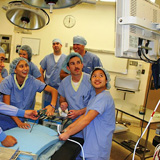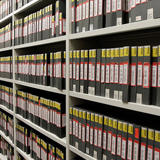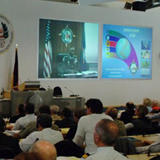
Metus MAM
Media Asset Manager and Archiving Solution
-
TV Broadcasting

-
Corporate & Education

-
Medical

-
Security-Surv. & Government

-
Post Production

-
Media House

-
Telecoms

Television companies value MAM’s support for industry standard formats, integration with editing and other broadcast systems, editing speed, the flexible deployment and robust management options, and the high availability and redundancy features. This makes it the ideal asset management tool for TV stations and playout head-ends.
Metus MAM’s extreme ease of operation of makes it possible to train non video professionals easily. This, coupled with the security of Metus MAM, make it ideal for Corporate, Educational and Government industries that need to manage their multimedia assets.
Metus MAM can now meet the requirements of the medical industry for safe and effective data management and DICOM file transfer. The latest version of Metus media asset management solution is compliant with DICOM and HL7 standards, international protocols that ensure the secure handling of medical imaging files and standardize the sharing of data between various systems and different organizations.
The high availability options of Metus MAM, combined with speed, ease of search, scalability, management and built-in access security features, makes it meet the challenge for mission critical deployments in the Security industries.
The video management functions of MAM, coupled with NLE integration and transcoding, make it an excellent choice for post-production facilities.
The ability to manage huge and constantly growing video archives, coupled with video transcoding, flexible export and delivery options, make Metus MAM the content management and distribution tool of choice for News Agencies and Media Monitoring Facilities.
The advanced video transcoding and packaging functions, combined with flexible metadata management, custom metadata export and high availability functions, make Metus MAM the perfect integration partner for middleware/webTV/IPTV management systems developers, and an ideal choice for telecoms operators as a Content Management System.
Introducing Metus MAM
MAM is a scalable media management system. Its asset management and transcoding tools helps workgroups catalogue, share and protect every asset and project, andoptimizes every file for use.
Metus MAM (Media Asset Manager) helps you do the following:
.png) Organize your media assets into an archive
Organize your media assets into an archive
.png) Track each file and project
Track each file and project
.png) Convert your assets in as many formats as you want
Convert your assets in as many formats as you want
.png) Help users find the right file fast
Help users find the right file fast
.png) Secure your archive with appropriate access rights granted to each user
Secure your archive with appropriate access rights granted to each user
.png) Export and deliver your assets in any format
Export and deliver your assets in any format
.png) Interface between your archive and 3rd partprocessing, editing and playout tools
Interface between your archive and 3rd partprocessing, editing and playout tools
.png) Keep track of actions performed on your archive Metus MAM is ideal for any organization that has a valuable and growing archive of media assets.
Keep track of actions performed on your archive Metus MAM is ideal for any organization that has a valuable and growing archive of media assets.

What are the benefits of Metus MAM?
Metus MAM has over 4000 installed users distributed around 50 countries. These include TV stations, head ends, telecoms, webTV, IPTV operators, corporates, educational institutions, production companies, media archives, government, militaryand security agencies. Read more about it.


Metus MAM is format agnostic, natively supporting open industry standard formats, including:
File wrappers: MPG, M2P, AVI, F4V, MXF, GXF, MOV, XDCAM, MP4, TS,
WMV, WAV, M4A, P2, Microsoft Smooth Streaming
Codecs: MPEG2, DV, DVCPRO, uncompressed, DVCPRO50, DVCPRO100HD, H.264, AVC, AVCIntra, Apple PRORES, IMX, VC-1, PCM, AAC, WMA Common image formats are supported as well as document format such as Word, Excel and pdf. It also supports popular archive formats like zip, rar etc.
 Processing
ProcessingMetus MAM’s built-in video processing engine Metus Process Server (MPS) is faster, and more feature-rich than many dedicated file transcoding products. For large systems it is deployable in a load balancing farm topology. It can be used to:
- Auto-generate proxies
- Transcode between file formats - during import, export, or any time in between, or based on a given schedule.
- Attach multiple transcoded versions of the file to the original assets, for instant on demand delivery in any format
- Cut, trim, paste and join video files for basic video editing
- Embed extra audio channels, surround sound
- Package to TS and adaptive bitrate formats for Internet delivery
Files created and transcoded by Metus MAM are frame accurate, so that users can seamlessly switch from proxy to hi-res during playback, or use the proxy files in editing software and switch on the timeline with hi-res versions later, without corrupting the edit.
 Storage Agnostic
Storage AgnosticMetus MAM supports NAS, DAS, SAN using Ethernet, fiber, iSCSI, SAS connectivity. MAM can also manage tape drives and libraries as nearline/offline storage or backup. The Information Lifecycle Manamagement (ILM) feature can automatically move files between tier 1, tier 2 and tier 3 storage systems based on access frequency, or other user-defined rules.
 Speed
SpeedMetus MAM is fast. Users can start working with assets as soon as the import starts. Videos can be played, trimmed, cut, even before they finish copying into the storage. Teams can even edit videos that are still being captured by Metus Ingest. Metadata can be input manually or automatically during or after capture.
The client user interface is entirely virtual. All objects, including bins, assets and even thumbnails are read from the database so browsing bins that contain hundreds of assets is very fast. Metus MAM even allows users to work on nearline/offline files, as if they were online, by keeping frame accurate proxy versions on HDD based storage.
 Ease of Use
Ease of UseMetus MAM is easy to use, with a single, intuitive interface. Importing assets is a matter of dragging and dropping files into the client interface, or copying them to a watch folder. Basic information about clips, like format, popularity and location are available on the thumbnail, and all metadata is available via the user interface in a single click. A storyboard timeline is automatically created to quickly navigate to the right point.
Clips can be played directly from the interface, or from a media player, where users can play at their preferred speed, and mark points and regions using keyboard shortcuts. Files with multiple audio channels are handled with ease. Users can even have one language on the left headphone and another on the right.
Organizing clips is as easy as dragging to a folder, metadata entry is a matter of clicking and typing. Search is as easy as using Google, or clicking on a folder. And export is as simple as dragging any authorised file.
 Metadata and Search
Metadata and SearchFor super-fast retrieval from archive, Metus MAM allows administrators to create unlimited metadata fields, categories and types.
Assets can be organized in virtual bins for easy access. Virtual assets from the same file can be created with different metadata. Searches can be performed Google-style as free text search, or users can build custom searches using any kind of existing metadata. Frequently performed searches can be saved as search bins, to be run at will. Users can even optionally perform an image search, to locate an image from all pictures and videos in the archive.
 Export and Delivery
Export and DeliveryMetus MAM enables users to deliver a large number of multimedia assets to multiple locations. Files can be made available to subscribers for web download via Metus Web client, or customized browser-based clients. Files can be automatically transcoded on-the-fly during export to any number of formats. If the exported files need to be imported to a third party system, custom xml based metadata form reports can be created and exported automatically together with the files.
 Security
SecurityBy default, file access is restricted to users running Desktop Client, with separate and individually assignable user permissions for adding, playing, editing, downloading and deleting assets.
Permissions can be assigned at the project, bins, or file level, or even on individual metadata fields. Users can be given the right to request a certain permission, which upon granting gives one-time user rights. Parts of assets can be limited to video or audio only, non-destructively hiding sensitive information from specific users.
 Management
ManagementThe archive is organized around Archive Projects, which encompass media files, metadata, and security. Different projects within the same Metus MAM installation, may have different media storage, archive servers, diverse metatada fields and different users.
Metus MAM’s User Actions monitors system events: every action is logged, together with where, when and by whom. This log can be easily browsed, sorted, filtered, shared and exported. All delete operations are virtual and can be retrieved from the built-in Recycle Bin by administrators. The assets can be optionally versioned so that changes on them (metadata or video) can be tracked and rolled back.
The Scalable Asset Manager
Built to accommodate every size of organization with changing needs, MAM can grow to support everything from a small local workgroup to a global enterprise. Metus MAM is a client server based system. As a scalable system, users can initially host multiple server side components on a single server. As the catalogue and users’ needs develop, each of the server components get be installed on its own server, or shared among multiple servers.
The components that make up a Metus MAM solution are: Read more about it.

 Metus Process Server (MPS), the File Processor
Metus Process Server (MPS), the File ProcessorMPS is the file professing engine that handles the following actions:
- Transcode between supported file formats
- Create low resolution proxies of assets for network and web based playback
- Trim clips and create new assets
- Join multiple files and clips
- Audio channel mapping, remapping and embedding
- Package to TS and adaptive bitrate VOD formats
- And many more video processing options
Metus Process Server runs on version of Microsoft Windows 2003 and 2008 Server, or Windows 7 Professional (64-bit)
Multiple MPS servers can be installed to scale the video processing power through intelligent load balancing.

Metus MAM can also be accessed and used by a lightweight, cross-platform web client. This client allows users to:
- Import video files - Enter metadata - Browse the archive - Play the proxy files. Metus Web Server (running on Windows 2003 or 2008) is required to host the web client Server.



- Regulate the media and data traffic - Apply security restrictions and user access rights to protect valuable assets
- Handles the archiving process, moving and distributing files to the appropriate storage location and delivers the file path to the client
- Manage the media life cycle of assets according to pre-set rules Additionally, it can function as a backup for other servers. Metus Archive Server runs on Microsoft Windows 2003 or 2008 64-bit Server and supports multiple NAS, DAS and SAN storage units. Multiple MAS servers can be installed for load balancing during archiving or for redundancy purposes.